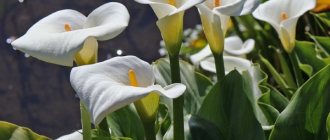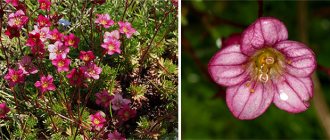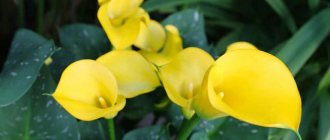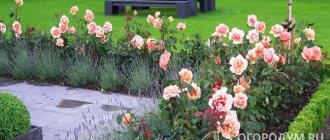00 : 00
00 : 00
- Listen to the article “Daffodils care in the open ground”
— — 19 : 37
Javascript Css Php Jquery Ajax
Narcissus is a monocotyledonous plant from the Amaryllis family. The peculiarity of the flower is that it is considered one of the earliest to bloom in spring. At the moment, about 60 different types of daffodils are known. Most of them are widely found in temperate climates, but throughout the world. Of these 60 species, gardeners use about 25. In addition, there are a dozen more hybrid daffodils.
In ancient times, this plant was given almost ritual significance. Moreover, among different peoples, narcissus had different meanings. For example, in the East, the narcissus was called nargis, and it was compared only with the beauty of the eyes of the beloved woman. In Europe, a narcissist is considered a declaration of love to this day, especially in Italy.
An exception is the narcissus in Greece, where for a long time this plant was used to clean people's deathbeds. By the way, one of the oldest Greek legends also refers to the narcissus, explaining its origin. We are talking about the guy of the same name who neglected the love of the nymph Echo. As punishment for this, the goddess of love, Aphrodite, bewitched the guy so that he would fall in love with his own reflection. So he admired himself until his death, and in this place flowers grew that received the guy’s name.
Actually, in addition to appearance, narcissus has extremely interesting properties. It is not for nothing that the root of his “name” is the Greek “narkao”, which translated means “to stupefy”. And it’s not surprising, because narcissus has an incredibly strong intoxicating odor that causes headaches. Among other things, narcotic or essential oils are made from it. Its bulbs are poisonous and contain the ingredient narcissin, which is one of the best means for controlling rodents.
Brief description of the narcissist
Narcissus is a flowering plant with dense bulbs and several leaves that are long and narrow in shape. They appear before the flowers, but they may not exist at all. Daffodil bushes can easily grow up to 50 cm in height.
Guseva Ulyana
Ask a Question
Question to the expert
Tell me, is it true that a narcissist has narcotic properties?
Not all types, but there are definitely some. Indeed, despite the aroma, the smells of most daffodils cause headaches. That is why it is not recommended to keep them at home.
Flowers form at the top of the stem. They are usually formed in inflorescences, including up to 8 peduncles. They can reach 10 cm in diameter. The petals have different shades, depending on the type and variety of narcissus, but there are also two-color varieties.
Daffodils also have fruit in the form of a box. This is where the seeds will be located.
general characteristics
Traditionally, the narcissus is considered a symbol of spring and beauty; in some mythologies it is even called a talisman of love. The flower is a bulbous plant. It belongs to the genus of monocots from the amaryllis family. The plant is classified as a herb that grows from dense bulbs with leaves that have a ribbon-like structure. The flowers are located at the tops of stems that do not have leaves.
Let's look at the characteristics of a narcissist.
- The perianth of the petal-shaped narcissus is shaped like a tubular funnel. At the top it turns into a bend, which consists of 6 parts. In the vent there is a bell-shaped crown - lobed or solid.
- The stamens are fixed in two rows at the top of the tube. The flower has an inferior ovary, a thread-like style and a blunt stigma. The fruit looks like a three-lobed capsule, which bursts into 3 parts along the valves. There can be a lot of seeds in it; they have a spherical shape.
- All spring flowers of this genus are considered poisonous, since they contain the alkaloid narcissin.
- Narcissus flowers have a persistent sweet smell that can confidently be called intoxicating. By the way, the words “narcissus” and “narcosis” have the same root, and this can be explained by the connection between the smell of the flower and its intoxicating properties.
- In ancient times, narcissus was often used in perfumery, but today it is virtually unused in this industry. This circumstance can be explained by the fact that synthetic flavors with an identical smell are much cheaper for the perfume industry.
If there are music lovers among the readers, they will probably remember the sad and mystical video of the Queen group “I’m going Slightly Mad”, at the beginning of which Freddie Mercury, already dying of AIDS, appears with a daffodil flower in his hand, and behind him is a whole lawn of white flowers. The metaphorical nature is obvious: Freddie and the creators of the video are talking in this way about the untimely death of the cult musician, which definitely cannot be avoided. And he, already on his deathbed, can sadly laugh at himself and his own narcissism.
But don’t associate daffodils only with sad symbolism. Still, this flower is too popular for associations with it to be entirely sad. Monocots are found everywhere - in the Mediterranean, southern Europe, and Asia. Gardeners actively cultivate 25 species of narcissus, as well as hybrid variations of the plant. For example, in Italy, to this day, a bouquet of daffodils given to a girl can be regarded as a declaration of love.
If you are planning to grow this plant, it will become the basis of your first real spring bouquets. They will decorate any room in the house (but preferably a spacious one, since the smell of the flower is still intrusive). Daffodils are simple but picturesque flowers, which is why many novice artists master watercolors with daffodils as their first sitters. In short, not the most demanding to care for, the “tenacious” flower has many meanings and is traditionally considered a harbinger of warm spring days.
Caring for daffodils in open ground
We began our article by calling the daffodil one of the earliest plants. This is true (with the exception of some varieties). Narcissist is rarely demanding, but he will still need to be looked after. That is why, if you do not have time for this, it is better to choose a less demanding flower. Otherwise, the narcissist will not be able to please you with all his beauty.
Site selection. Lighting.
Actually, when planting garden flowers, everything always starts with choosing the area where you want to grow flowers. In the case of daffodils, it must be well lit. The soil must have good drainage properties. The soil must be of high quality and fertilized.
Never plant daffodils in areas where tulips, chrysanthemums, lilies, asters or phlox previously grew. The best predecessors of daffodils are peonies, cereals, and cucumbers.
Can you grow it at home?
Not all gardeners know that daffodils are quite easy to grow at home. To do this, at the beginning of March, the preserved onion needs to be planted in a pot with nutritious soil, watered regularly, and a small amount of dissolved ammonium nitrate added once every two weeks.
Usually no problems arise during cultivation. The main thing is to protect the sprout from drafts. Within a few weeks of planting, you will be able to enjoy the beauty of this exquisite plant.
Care after flowering
Once your daffodils have finished blooming, you should continue caring for them and the soil for a while longer (about 3 weeks). Actually, you will need to water the plant and periodically loosen the soil around them. Fading flowers - cut off immediately, otherwise the bulbs will not form well, which will subsequently affect the development of the plant.
Planting daffodils in open ground
Boarding time
In the case of the time of planting daffodils, you will need to navigate individually. As we said above, you will need good weather, so each one is guided by their place of residence.
Like many other bulbous crops, daffodils are recommended to be planted in the fall. Ideally this is the beginning of September.
When planting daffodils, keep in mind that they will need about a month to “get involved.”
However, in this regard, narcissists are unpretentious. You can plant them in both spring and winter. The main thing is to process the bulbs before doing this. Additionally, they can be “hardened” by placing them on the refrigerator shelf for a couple of months. You can plant such bulbs in early April. The only condition is that there is no snow.
Spring planting
Before planting, you will need to thoroughly loosen the soil in the area where you will subsequently grow daffodils. Fertilize the bud using 60 grams of humus per 1 m². Also add some sand. You can plant daffodils without any preliminary steps, but the soil, in this case, must be suitable for them.
Before planting, immediately prepare the holes for the bulbs. In size it should exceed 3 bulb sizes. Add a grain of sand and a grain of wood ash to the hole. Fill the hole halfway with a mixture of earth and humus, and then bury it with the rest of the soil.
Be sure to water the entire planting thoroughly.
Question to the expert
Tell me, does it matter what time of year you need to plant daffodils?
Absolutely none. The main thing is proper care of the bulbs and soil before planting. Everything else is trifles.
As for the distance between the holes, everything will depend on what you are planning in the future. If you are going to plant daffodils next year, then 10 cm is enough, and if you planted them for a long time, then at least 20 cm. Additionally, the planting site can be covered with a layer of mulch. This will retain moisture and also discourage weed growth.
Pruning in autumn
In autumn, pruning is necessary for flowers - this way the plant will prepare for unfavorable winter conditions. The procedure is carried out before frost in October - the leaves are removed. There are several tips on how to prune irises in the fall:
- you need to cut the foliage into a cone, this way there will be less moisture on the surface;
- Leaves up to 15 cm tall are not touched;
- when cutting irises, the removed parts must be burned;
- rhizomes are covered with a layer of soil;
- if it is winter with a small amount of snow, then the flowers are completely covered.
Thus, when it’s time to cut irises for the winter depends on the growing region. Somewhere frosts may come earlier.
Transplanting daffodils
Recommended by topic
Night violet Peonies Catharanthus
As we said earlier, daffodils can easily live in one place for many years. However, sooner or later, you will have to replant them. When the time comes, you will see it by their appearance. For example, there are signs by which this is easy to understand:
- The flowers begin to shrink.
- The quality of the flowers has deteriorated.
- The plant no longer blooms as luxuriantly as before.
- The daffodil foliage is beginning to wilt.
Do not forget that replanting should be done only when the daffodils have finished blooming. Otherwise you will ruin the plant.
Actually, transplantation and propagation of daffodils is carried out by dividing the bulbs. Dig up a flower, clear it of the soil, separate the “children” from the “parents”. As a rule, these are 3-4 small onions. Inspect them all, make sure that there are no sick people or pests among them.
Do not cut live roots from the bulbs under any circumstances.
Next, you will need to treat them in a solution, dry them, put them in a cool place, and in a couple of months you will be able to plant daffodils in open ground according to the scheme we described above.
On a note
- Only large bulbs are capable of growing at home.
- Before planting, do not forget to remove old roots.
- Before combining daffodils into a single bouquet with other flowers, it is worth placing the daffodils separately in a jar of water so that the poisonous juices pour out of them. Only after 24 hours can you wash their stems under running water and combine them into a single bouquet.
Propagation of daffodils
Actually, as we said above, daffodils can be propagated by bulbs, or grown from seeds. We told you about the first case, but as for the second, the situation is a little more complicated. You will need, in the summer, to collect the seeds and, while they are still wet, plant them in pots.
Actually, flower growers do not recommend this method, because... it's too labor intensive.
Among other things, you will have to wait about 7 years for a daffodil grown from seed to bloom on its own. For self-seeding, this is normal, but you will simply get tired of waiting, or you will forget about them.
Groups
Large-crowned daffodils . They have single flowers, the height of the crown is about 1/3 of the diameter of the perianth. The largest variety of colors.
Terry daffodils . The flowers are large, the center of the flower is of various colors, the petals are pink and coral tones. Peduncle of medium height.
Jonquil daffodils . A very resilient group with a strong aroma. There may be several flowers on a peduncle. They bloom later than others and can grow without transplanting for 6-7 years.
Daffodils with a split crown . The perianth and crown fit tightly to each other. Flowers up to 20 cm in diameter!
Cyclamenoid daffodils . A peculiarity is that the outer perianth petals are much narrower than the lower ones.
Tubular daffodils . The length of the crown is equal to the diameter of the perianth. They are distinguished by tall peduncles. Colors: white, yellow, bicolor.
Diseases and pests
Diseases
As for diseases, daffodils are most susceptible to fungal diseases, gray rot, fusarium, penicillosis, etc. All these diseases cause the daffodils to rot and then die. They develop for one reason only - excessive moisture.
To avoid fungal diseases of narcissus, you need to treat the sprouts with one and a half percent Bordeaux mixture.
Daffodils are also susceptible to viral diseases, which can enter the plant from anywhere. It is impossible to cure them. However, you can prevent the disease. To do this, fight pests, plant only healthy bulbs, and immediately dig up and burn damaged bushes.
Pests
As for pests, daffodils are susceptible to attack by mole crickets, root mites, nematodes, slugs and daffodil flies. From them, you disinfected the plant in solution at the planting stage. However, if the reptiles do appear, immediately rush to specialized stores to buy poison.
Seed storage rules
Their germination and, accordingly, the density of the flower bed in the spring depend on the correct storage of the bulbs. What rules must be followed?
The dug up seeds are washed and dried (it is advisable to use a box with a mesh bottom for this) in a well-ventilated area, protected from direct sunlight. The optimal temperature is 20–25 degrees.
The bulbs are then placed in paper or fabric bags and stored at a temperature of 15–17 degrees Celsius.
Well, at the end of August or beginning of September you can plant them again to enjoy the most beautiful flowers in the spring.
Pros and cons of narcissists
Conclusion
Beautiful appearance
Unique properties
Stunning aroma
Huge number of species
Long-lived
Susceptible to pest attacks. It gets sick if not taken care of properly.
Requires constant care
To summarize, we can say the following. Narcissus is an extremely capricious plant, although it cannot be called too demanding. In general, if you are looking for a plant that you will constantly care for and that will thank you for it with its beauty, the narcissus is definitely for you.
How to store bulbs
Until September, the bulbs should be kept in a wooden box or box in a place where it is not very warm. It is optimal if the temperature does not exceed +18 °C.
But for the winter it is better to put them in a cool place, with an air temperature of about +10 °C and humidity not higher than 70%. Once a week you need to check how the “harvest” is doing.
Dispose of spoiled specimens immediately. If stored improperly, the bulbs may develop diseases such as gray rot.











